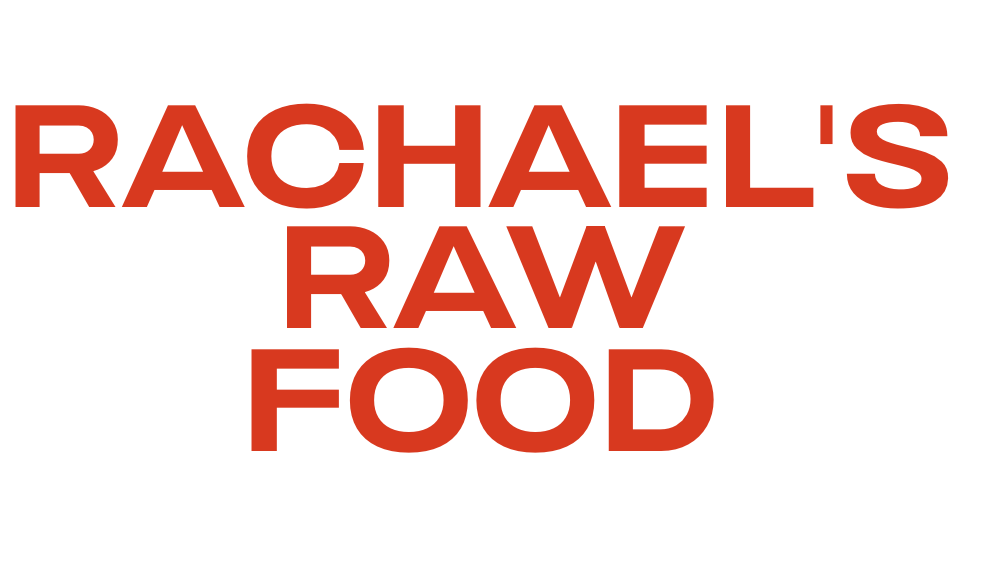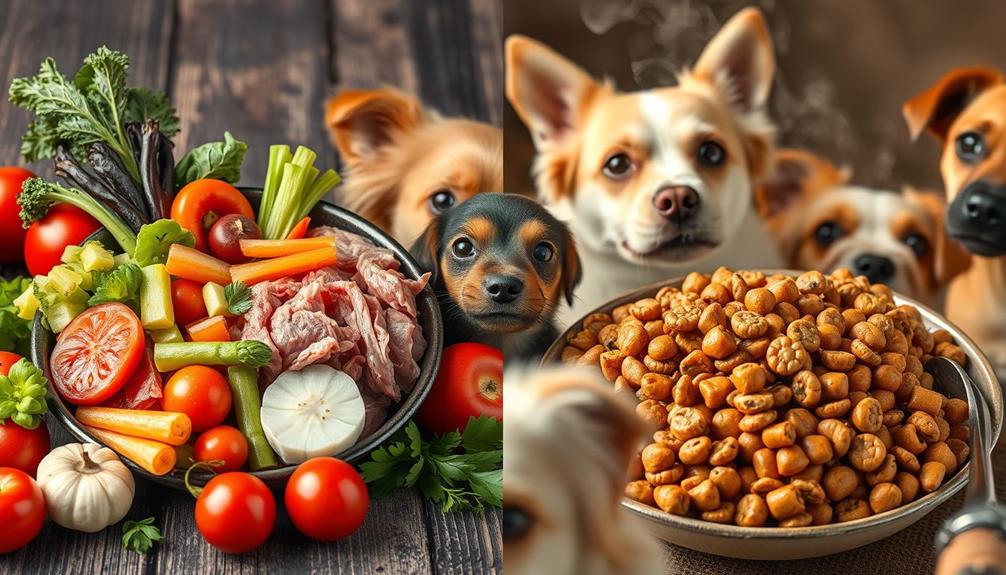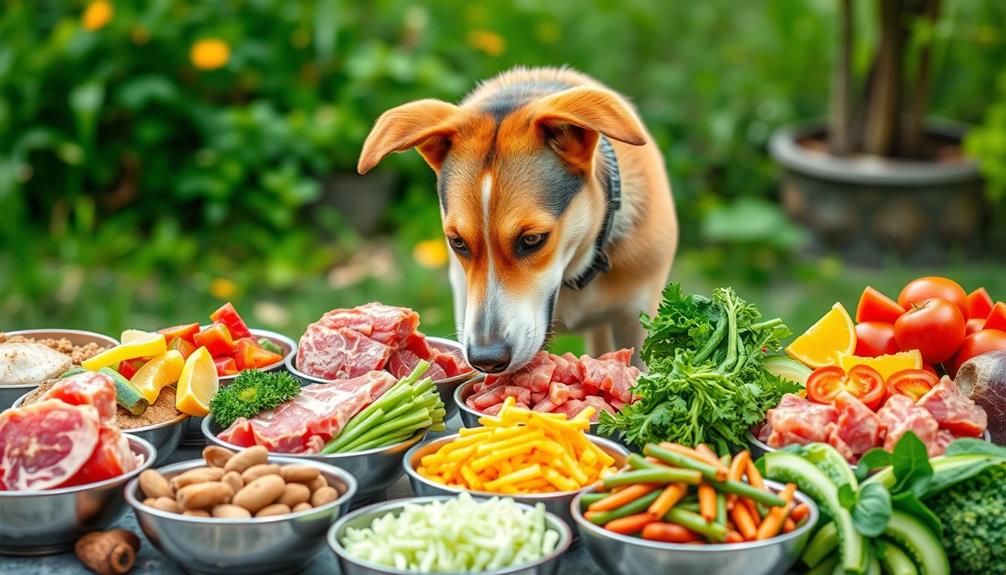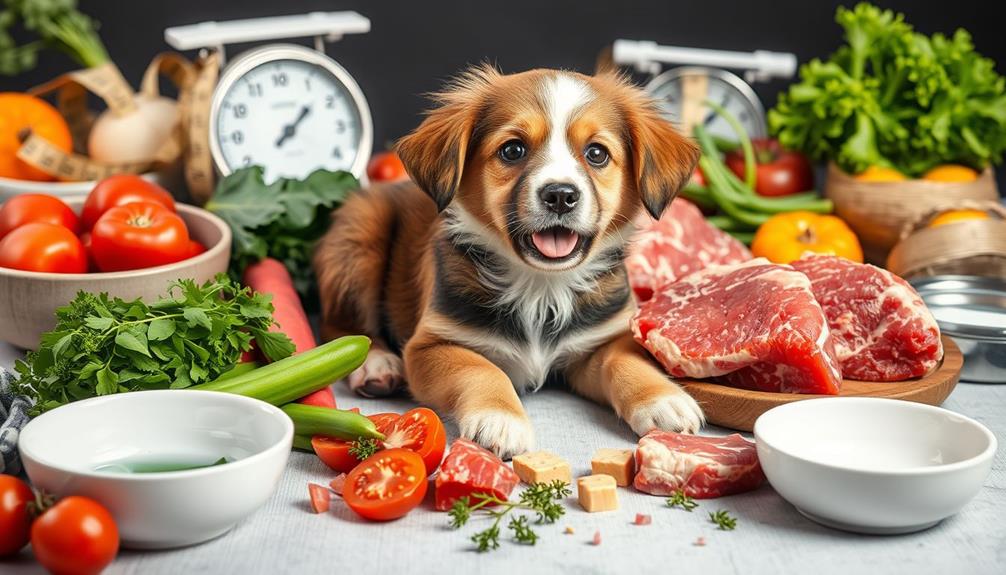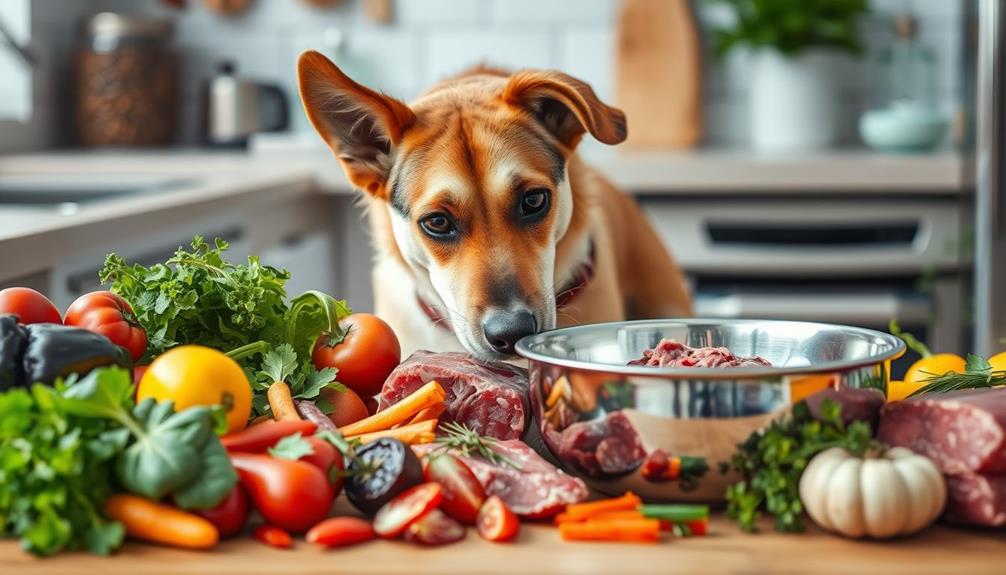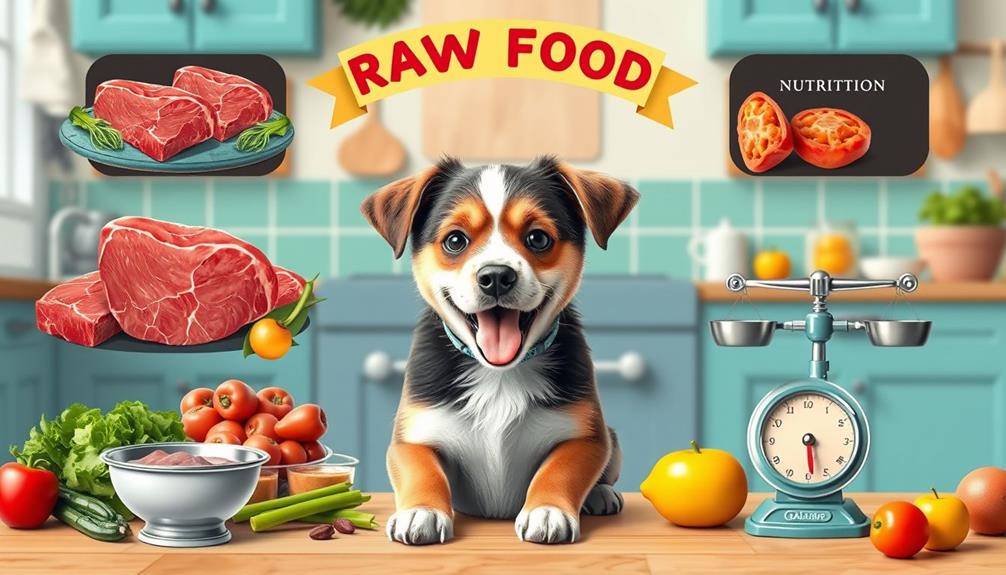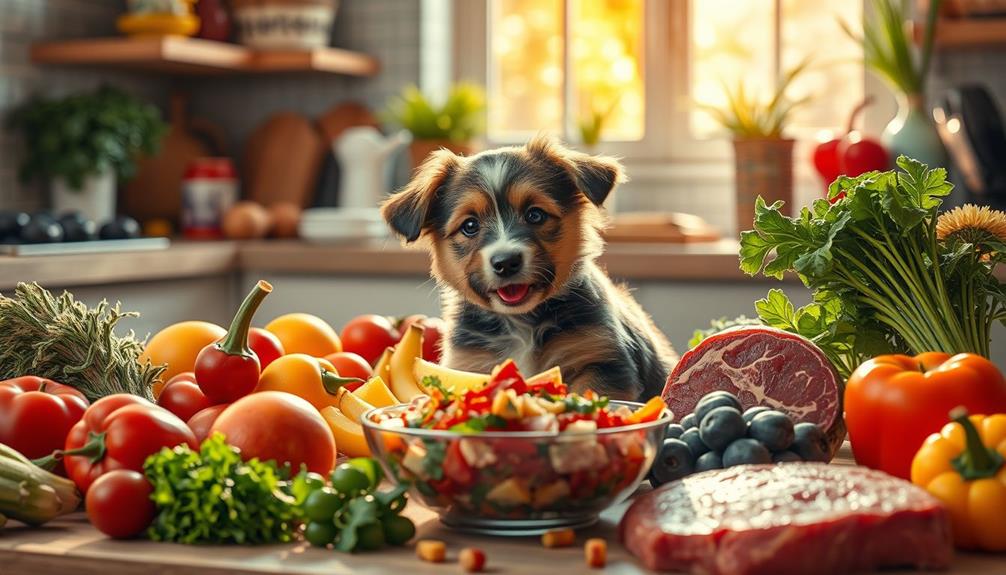When choosing between raw and cooked food for your dog, you'll notice key differences in nutrition and safety. Raw diets offer higher bioavailable nutrients and promote better digestion, while cooked meals enhance nutrient absorption and eliminate harmful bacteria. Raw feeding supports dental health but requires careful handling to avoid pathogens. Cooked food might be more budget-friendly and convenient, especially for busy lifestyles. Each option has its benefits and drawbacks, so consider your dog's specific needs. You'll discover useful tips and insights to help you decide what's best for your four-legged friend.
Key Takeaways
- Raw dog food offers higher bioavailable nutrients and promotes better digestion through natural enzymes, while cooked food enhances digestibility of certain nutrients.
- Cooking eliminates harmful bacteria, reducing foodborne illness risks, whereas raw diets require careful handling to prevent contamination.
- Raw diets support dental health by promoting natural chewing behaviors, while cooked diets can include fiber-rich vegetables for better digestion.
- Cost and accessibility vary; raw diets may be pricier due to quality ingredients, while homemade cooked meals can be more budget-friendly.
- Transitioning between diets should be gradual, monitoring for digestive changes, and consulting a veterinarian is recommended for balanced nutrition.
Nutritional Value Comparison
When it comes to the nutritional value of your dog's food, what's the real difference between raw and cooked options? Raw dog food typically boasts higher bioavailable nutrients, including proteins, essential fatty acids, and vitamins, compared to cooked dog food, which often loses nutritional value during high-heat processing.
Cooking can destroy crucial enzymes and amino acids, reducing overall digestibility and nutrient absorption for your dog. Additionally, juicing can provide health benefits that might inspire pet owners to explore fresh, whole food options for their dogs.
While both raw and cooked diets can meet canine nutritional needs, raw diets generally require less supplementation with synthetic additives to compensate for lost nutrients. This makes raw dog food a more natural choice for some pet owners.
Studies indicate that whole food diets, including both raw and gently cooked options, are generally more digestible than kibble. However, neither raw nor cooked options show significant differences in digestibility when comparing raw and cooked ingredients directly.
It's important to note that poorly formulated raw diets can lead to nutritional imbalances, so careful planning is crucial to guarantee all essential amino acids and fatty acids are included.
Ultimately, the choice between raw and cooked comes down to your dog's specific needs and your feeding philosophy.
If your dog has a sensitive stomach or food allergies, a raw diet might be the best option to meet their specific dietary needs. On the other hand, if you prioritize convenience and safety, cooked dog food may be a better fit for you and your pet. Regardless of your choice, it’s essential to carefully research and select the best cat food options or dog food for your furry companion to ensure they receive the proper nutrition for their health and well-being.
Safety and Preparation Methods
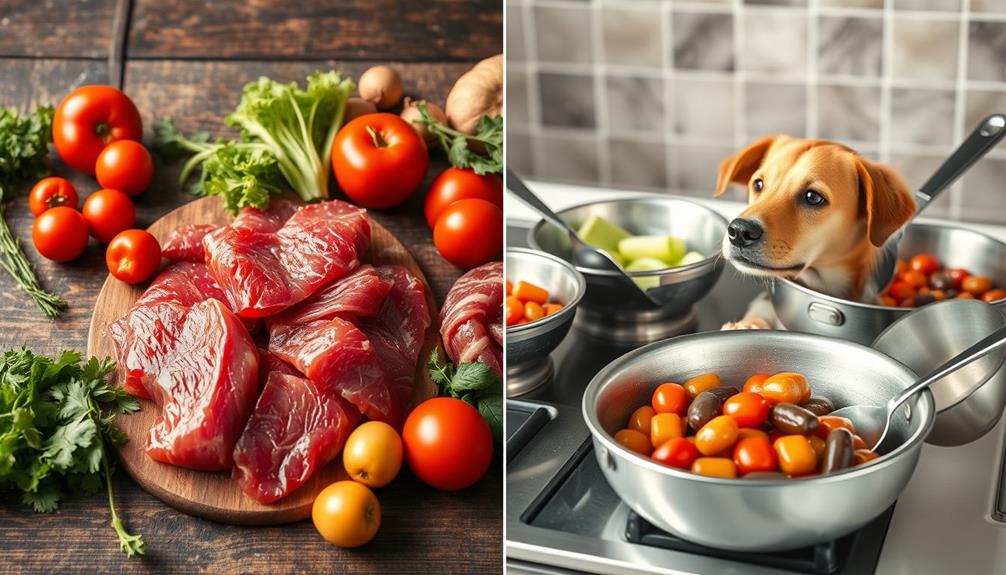
When preparing food for your dog, handling raw ingredients safely is key to preventing harmful bacteria like Salmonella and E. coli.
It's important to maintain a clean preparation area and to wash your hands and surfaces thoroughly after handling raw ingredients.
Cooking methods can help eliminate these risks, ensuring a safer meal for your pet and your household.
Let's explore the best practices for both raw and cooked diets to keep your dog healthy, including insights on hamster care and costs.
Handling Raw Ingredients Safely
Handling raw ingredients safely is crucial to protecting your dog's health. When preparing raw dog food, you must follow proper hygiene practices to minimize the risk of bacterial contamination, like Salmonella and E. coli. Always wash your hands, utensils, and surfaces thoroughly after handling raw ingredients.
Regular cleaning and avoiding irritants can reduce the chances of contamination, similar to the aftercare needed for body piercings to prevent infection piercing aftercare tips.
Store raw meat at ideal temperatures below 40°F (4°C) to prevent spoilage, and remember to discard any uneaten portions promptly to avoid pathogen growth. When defrosting frozen raw food, use the refrigerator instead of leaving it at room temperature to reduce the chances of bacterial proliferation.
To guarantee food safety, use separate cutting boards for meat and other ingredients to avoid cross-contamination. This practice helps keep your kitchen food safe and protects your dog from harmful pathogens.
Also, always adhere to safe food handling guidelines. If you're mixing raw ingredients, be sure to cook surfaces to 165°F (73.9°C) when applicable, as this will eliminate potential pathogens.
Cooking Methods Overview
Cooking dog food safely requires a thoughtful approach to preparation and technique. When you choose to prepare cooked dog food, it's essential to use safe cooking methods that maintain the nutrients while eliminating harmful pathogens often found in raw ingredients.
Gently cooked dog food is a great option, as it can provide a balanced diet while mitigating health problems associated with feeding raw, like salmonella and listeria infections. Additionally, considering the importance of cold medications overview can help you understand the potential impacts on your dog's health if they're sick while changing diets.
The cooking process should focus on preserving the nutritional differences between raw and cooked meals. For instance, steaming or baking can help retain those important vitamins and minerals.
Additionally, proper handling and storage of cooked dog food are significant to minimize bacterial contamination, especially if there are vulnerable individuals in your home.
If you're moving from raw dog food to cooked meals, do it gradually. This approach helps avoid gastrointestinal upset, making the adjustment smoother for your dog.
Health Benefits of Each Diet
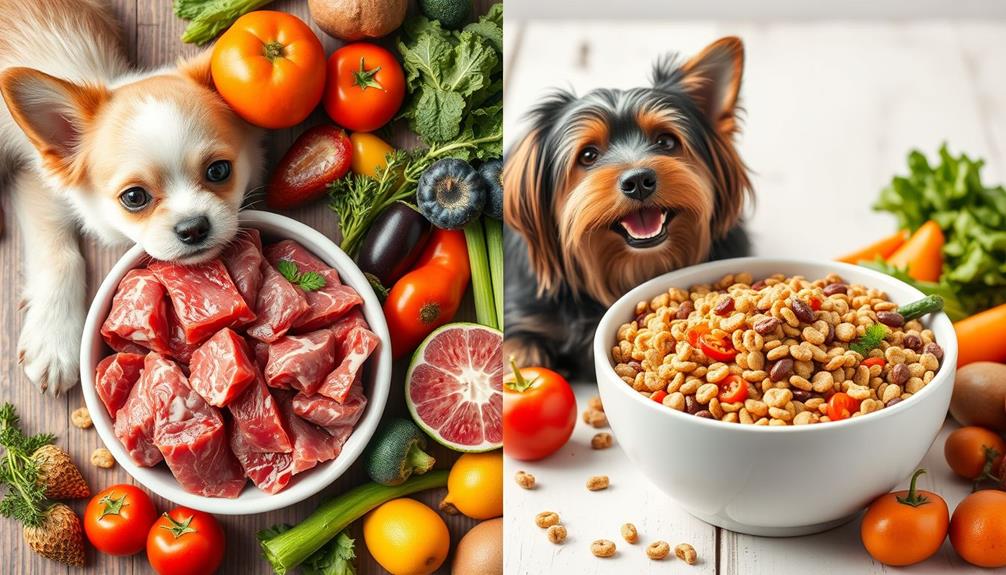
When considering your dog's diet, it's important to weigh the health benefits of raw versus cooked meals.
Raw food can provide superior nutrition and support dental health, potentially enhancing their overall well-being. Additionally, understanding your dog's unique dietary needs can help you make informed decisions about their nutrition, including aspects like budgeting for pet food.
On the other hand, cooked options prioritize safety and nutrient absorption. Each diet has its unique advantages, so let's explore how they affect your dog's overall well-being.
Nutritional Advantages of Raw
Raw dog food diets offer significant nutritional advantages that can greatly enhance your dog's health. One of the key benefits is the higher bioavailability of nutrients found in raw food. Unlike cooked diets, which often lose crucial components due to high heat processing, raw diets retain natural enzymes and amino acids that improve digestion efficiency. This means your dog can absorb more nutrients effectively.
Additionally, incorporating essential oils for skin conditions into your dog's grooming routine can further enhance their overall health.
Moreover, raw feeding provides high protein levels, essential fatty acids, and vitamins that contribute to better coat condition, skin health, and increased energy levels. You'll also notice that raw food promotes dental health, as it encourages natural chewing behaviors that help reduce plaque and tartar buildup, unlike softer cooked foods.
Another advantage is that well-formulated raw diets are less likely to cause nutritional deficiencies. Cooked diets often require synthetic additives to replace nutrients lost during cooking, leading to potential imbalances.
Benefits of Cooked Meals
Opting for cooked meals can bring a host of health benefits for your dog. One major advantage is the reduced risk of foodborne illnesses. Proper cooking eliminates harmful bacteria like Salmonella and E. coli, keeping your furry friend safe. Additionally, cooking can enhance the digestibility of certain nutrients, making it easier for your dog to absorb essential vitamins and minerals.
Here's a quick look at some benefits of cooked meals:
| Benefit | Description |
|---|---|
| Reduced Foodborne Illnesses | Cooking eliminates harmful bacteria. |
| Improved Digestibility | Cooked meals help in the absorption of nutrients. |
| Balanced Proteins | Gently cooked meals provide a balanced ratio of proteins, carbohydrates, and fats. |
| Weight Management | Freshly cooked food helps control calorie intake. |
| Added Fiber | Incorporating vegetables contributes to healthier digestion. |
Digestive Health Comparisons
Digestive health is essential for your dog's overall well-being, and both raw and cooked diets offer distinct benefits. Raw dog food is often easier to digest due to its high protein levels and natural enzymes, which enhance nutrient absorption and digestive efficiency.
Additionally, incorporating healthy dog snacks can further support your dog's digestive system and overall health. Studies show that whole food diets, including both raw and cooked formulations, have higher digestibility than processed kibble. However, raw diets maintain consistent digestibility, which can be vital for your dog's gut health.
The natural ingredients found in raw feeding can promote healthier gut flora, leading to smaller, firmer stools. This aligns more closely with your dog's evolutionary dietary needs, potentially enhancing overall digestive function.
On the other hand, cooked food can provide essential fiber from vegetables, which supports digestion and helps ease the shift from processed kibble to a more natural diet.
While both diets can support digestive health, your choice may depend on your dog's individual needs. If you aim for ideal nutrient absorption and gut flora balance, raw dog food could be the way to go.
Ultimately, consider your dog's specific health requirements when deciding between these two approaches.
Cost and Accessibility Factors
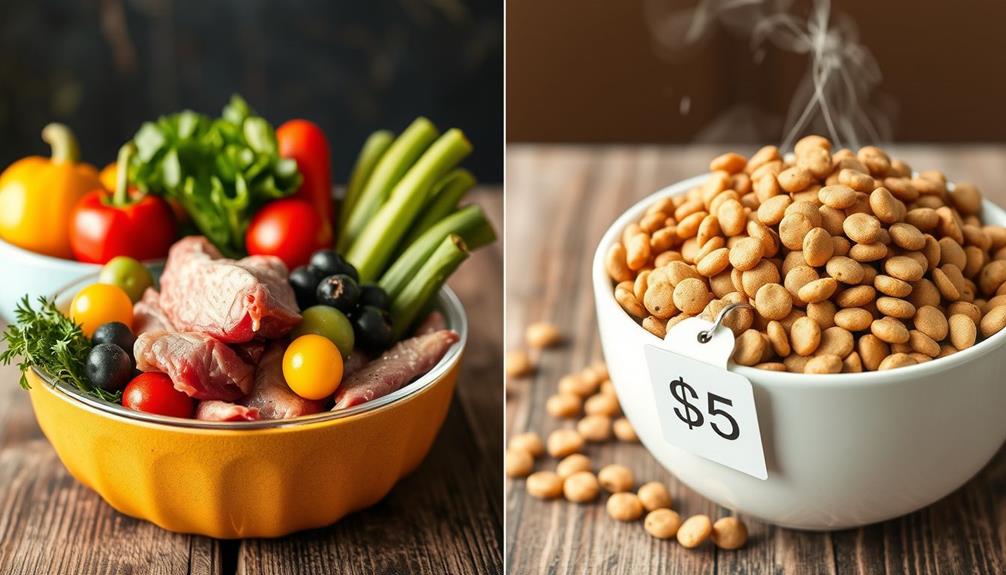
When considering cost and accessibility factors for dog diets, it's important to weigh the benefits of each option. Raw dog food often comes with a higher price tag due to the high-quality ingredients and sourcing needed. This can make it less accessible for pet owners, especially in regions lacking reliable suppliers.
Additionally, just like with home appliances, the quality and efficiency of ingredients can impact the overall health of your pet, similar to how energy-efficient appliances can lower energy consumption and costs.
On the other hand, homemade cooked meals can be more budget-friendly, allowing you to control ingredient quality while potentially lowering costs compared to pre-packaged options.
Convenience plays a significant role in your decision. Pre-packaged cooked meals offer ease of use, which can be appealing for busy pet owners. However, they often come at a higher price compared to raw food options.
If you find yourself short on time, cooked meals might help you stick to a consistent feeding routine, ensuring your dog gets balanced nutrition without the hassle of preparation.
Ultimately, it's important to evaluate your budget and the accessibility of quality ingredients in your area. By doing so, you can make an informed decision that aligns with your financial situation and your dog's dietary needs.
Owner Preferences and Lifestyle
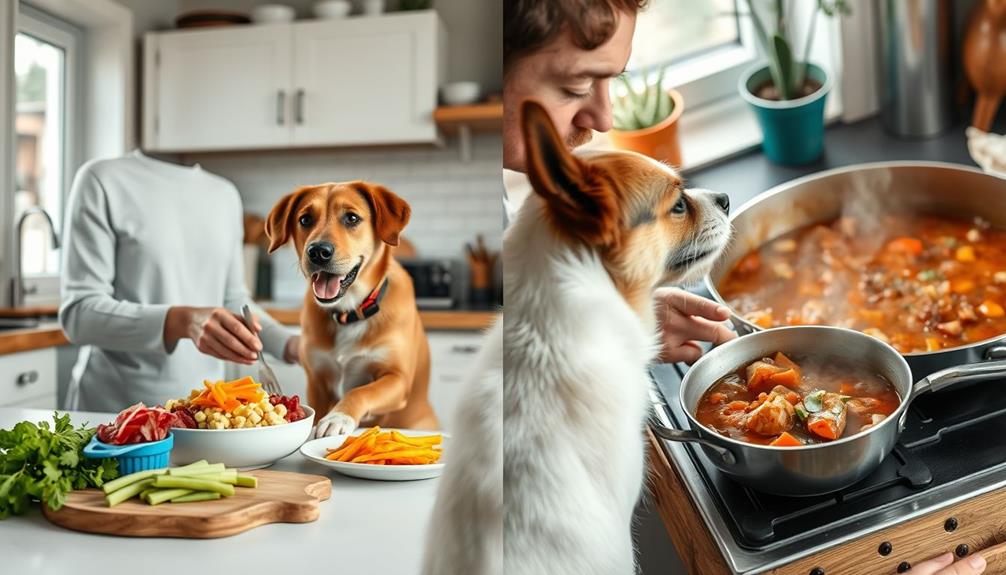
Many dog owners find that their preferences and lifestyles play an essential role in choosing between raw and cooked diets. Your dog's individual tastes can greatly influence your decision; some dogs may prefer the taste and texture of raw dog food, while others might favor cooked options.
Understanding the importance of financial considerations for elderly care can also parallel the investment you make in your dog's nutrition, emphasizing the need for high-quality, meat-forward brands for both feeding methods. Ensuring your pet receives ideal nutrition aligns with your values regarding animal welfare.
Your personal beliefs about health and nutrition also shape your choices. If you prioritize convenience and have a busy lifestyle, cooked diets for dogs might be more suitable, as they require less time and effort in sourcing and preparing ingredients.
On the other hand, raw feeding demands a commitment to ensuring your dog's nutritional needs are met, which may not fit every owner's routine.
Education on canine nutrition is crucial for making informed decisions. Understanding the benefits and challenges of both raw and cooked diets can help you choose the best option that aligns with your lifestyle and meets your dog's dietary requirements.
Ultimately, it's about finding a balance that works for both you and your furry friend.
Transitioning to a Raw Diet
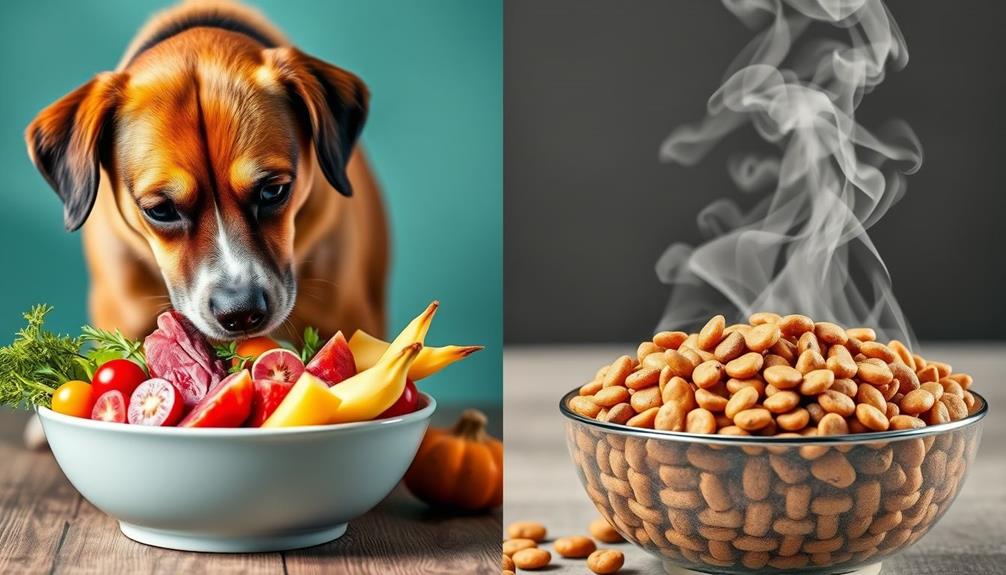
Altering your dog to a raw diet can be a rewarding process, but it requires careful planning. You have two main options for altering to a raw diet: a straight swap or a gradual introduction. The latter involves mixing small portions of raw dog food with your dog's current diet to ease the change.
It's important to remember that some dogs may experience digestive changes during the alteration, so monitoring their response is key, especially regarding pet considerations regarding ice cream.
Here are some key points to take into account:
- Duration of Alteration: The time it takes varies based on your dog's adaptability.
- Maintain a Consistent Feeding Routine: Consistency is vital during this period to help your dog adjust.
- Consulting with a Veterinarian: It's important to verify the new diet meets your dog's nutritional needs.
Hybrid diets, which combine raw and cooked food, can also be effective. They allow your dog to enjoy the benefits of raw dog food while still providing familiar elements of their existing diet.
If you have a puppy, begin the alteration post-weaning with age-specific options. Remember, the goal is to create a balanced diet that supports your dog's health and well-being.
Raw Feeding Overview
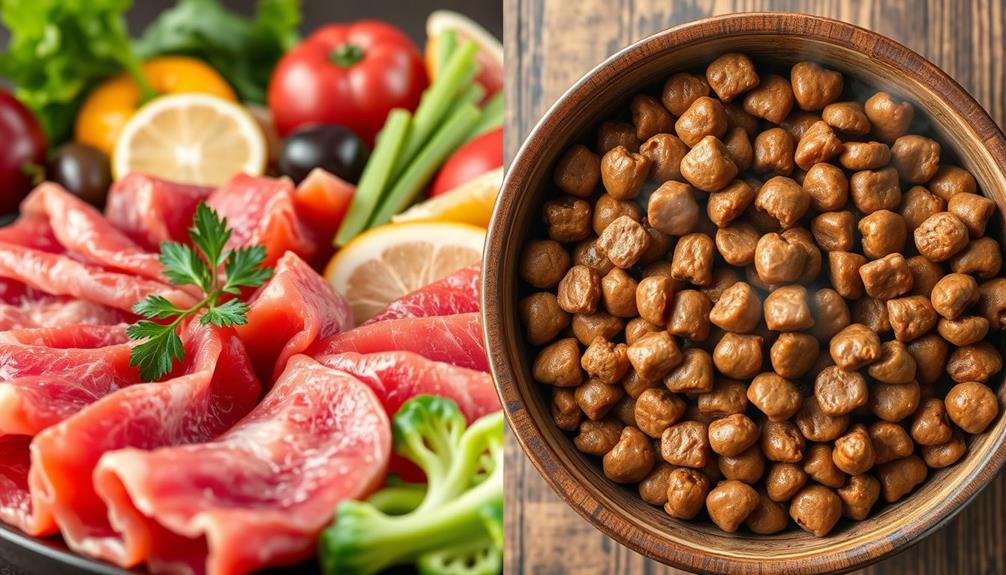
Raw feeding offers an approach to canine nutrition that emphasizes uncooked foods like meat, bones, fruits, and vegetables, aiming to replicate what your dog's wild ancestors would have eaten. Many advocates believe that a raw food diet can lead to benefits such as improved coat condition, better digestion, and increased energy levels due to the preservation of natural nutrients and enzymes. However, you should be aware of the potential drawbacks as well.
| Aspect | Benefits | Concerns |
|---|---|---|
| Nutritional Balance | Promotes natural nutrition | Risk of nutritional imbalances |
| Food Safety | Fresh, unprocessed ingredients | Potential pathogens, bacterial contamination |
| Digestive Health | Easier for some dogs to digest | Choking hazards from bones |
| Energy Levels | Enhanced vitality | Requires careful monitoring |
To guarantee your dog's health, it is crucial to maintain a balanced raw diet that meets their nutritional needs. Consulting with a veterinarian or pet nutritionist can help mitigate risks associated with raw feeding, as well as improve food safety practices to minimize health concerns.
Advantages of Cooked Dog Food
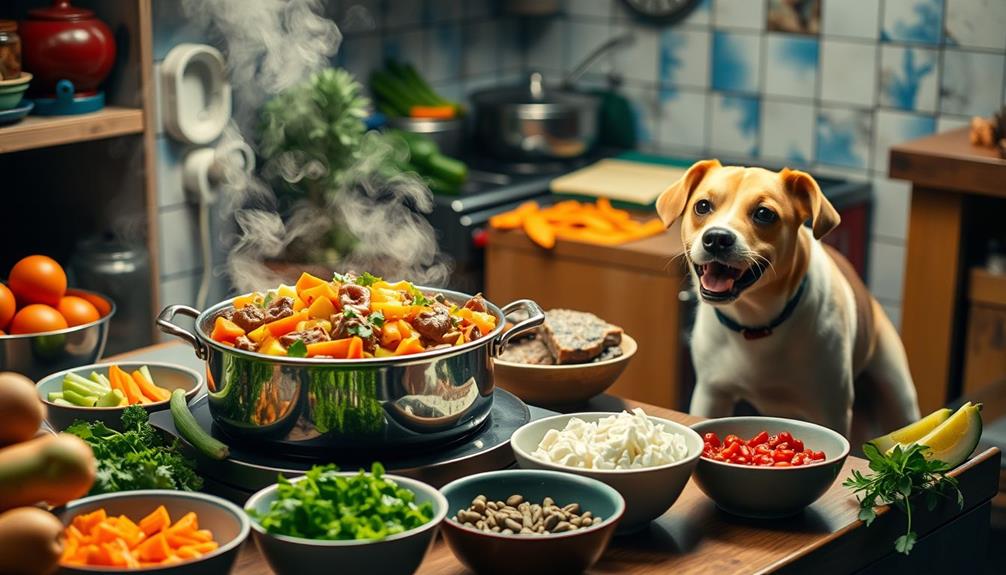
Cooked dog food offers a safe and nutritious alternative to raw diets, making it a popular choice for many pet owners. By cooking your dog's food, you reduce the risk of bacterial contamination often associated with raw meat, providing peace of mind for households, especially those with vulnerable individuals.
Additionally, when prepared properly, freshly cooked meals can retain essential nutrients, enhancing digestibility compared to commercial kibble.
Here are some advantages of cooked dog food:
- Personalized Dietary Choices: You can tailor meals to meet your dog's specific health needs and preferences.
- Nutritionally Balanced Diet: Offering a variety of ingredients can help prevent dietary boredom while ensuring a balanced intake of nutrients.
- Weight Management: Cooked diets allow for controlled calorie intake, helping you maintain a consistent, measured diet for your dog.
Ultimately, choosing cooked food for your dog not only supports their health but also gives you the ability to create meals that cater specifically to their unique requirements.
With the right ingredients, you can create a diet that keeps your furry friend happy and healthy.
Disadvantages of Cooked Dog Food
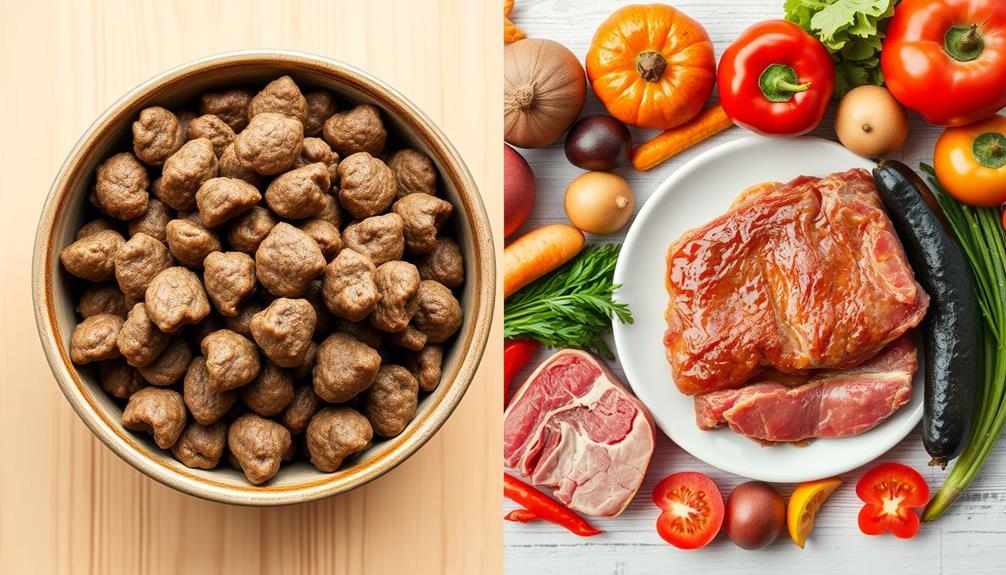
While many pet owners appreciate the benefits of homemade cooked dog food, there are notable disadvantages that shouldn't be overlooked. One major challenge is maintaining nutritional balance. Without proper guidance, you might inadvertently create meals that lack essential nutrients, risking your dog's health.
Additionally, sourcing fresh high-quality ingredients can lead to higher costs compared to commercial dog food options, putting a strain on your budget.
Another disadvantage is the shorter shelf life of cooked meals. You'll need to plan meals carefully and store them properly to prevent spoilage, which can be time-consuming and inconvenient.
Furthermore, if you decide to shift your dog from kibble to homemade cooked food, be aware that a sudden change can lead to gastrointestinal upset. It's vital to adopt a careful approach, gradually introducing cooked meals to minimize digestive issues.
Lastly, the effort required to guarantee safe cooking practices can be overwhelming for busy pet owners. Balancing all these factors can make homemade cooked dog food a challenging commitment, so weigh the pros and cons to determine the best option for your furry friend.
Frequently Asked Questions
Is It Better to Feed Dogs Raw or Cooked Food?
Deciding whether to feed your dog raw or cooked food depends on their individual needs. Consider their health, preferences, and any potential risks. Consulting your vet will help you make the best choice for your pup.
Do Vets Recommend a Raw Diet for Dogs?
Many vets have mixed opinions on raw diets for dogs. While some recognize the potential benefits, they often caution against risks like bacterial contamination. It's important to consult a specialist for safe, balanced nutrition.
Is Raw Food Actually Better for Dogs?
You might find raw food beneficial for dogs due to its higher nutrient bioavailability and digestive efficiency. However, be cautious about nutritional imbalances and food safety risks, ensuring you provide a balanced, safe diet.
What Is the Healthiest Food to Feed Your Dog?
The healthiest food for your dog combines high-quality proteins, essential fatty acids, vitamins, and minerals. Balanced nutrition is key, so consider consulting a vet to guarantee their specific dietary needs are met effectively.
Conclusion
To sum up, choosing between raw and cooked food for your dog depends on your pet's needs and your lifestyle. For example, if you've got a busy schedule, like Sarah, who works long hours, she found that cooking her dog's meals in batches saved time while ensuring quality nutrition. Ultimately, whether you opt for raw or cooked, understanding the pros and cons will help you make the best choice for your furry friend's health and happiness.
